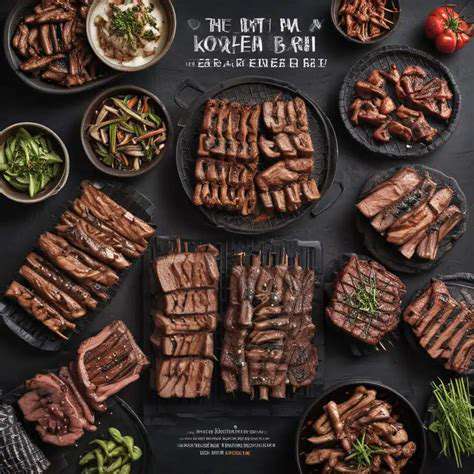Discovering Korean BBQ: Essential Marinades and Grilling Tips
The soul of Korean BBQ lies in its marinades. These complex mixtures balance flavors perfectly - savory soy sauce, spicy gochujang, aromatic garlic and ginger create magic. Each ingredient plays a specific role in flavor development, with some recipes including fermented kimchi or honey for extra depth.
Marinades vary by region and family tradition. Some use pear juice for natural tenderizing, while others add sesame oil for richness. Experimenting with different combinations helps you find your perfect flavor profile. Remember, marinating time affects both tenderness and taste intensity.
Essential Grilling Techniques
Grilling Korean BBQ requires attention to detail. High heat creates a perfect sear while locking in juices. Temperature control is crucial - too low and the meat stews, too high and it burns. Learning to judge doneness by touch and sight becomes second nature with practice.
A meat thermometer takes the guesswork out of grilling, especially for beginners. Different cuts require different cooking times - thin slices cook quickly while thicker cuts need patience. The sizzle, the aroma, the gradual color change - all signal when your meat reaches perfection.
Beyond the Meat: Accompaniments and Sides
Korean BBQ shines with its banchan (side dishes). Spicy kimchi, crisp vegetables, and various sauces create a symphony of flavors. These sides aren't just extras - they complete the meal, balancing rich meats with fresh, tangy contrasts.
Discovering perfect pairings enhances the experience. Try ssamjang (spicy dipping sauce) with pork belly, or cool cucumber salad with spicy beef. The interplay of flavors and textures makes each bite unique. Don't forget steamed rice to soak up delicious juices.
Essential Korean BBQ Marinades: Beyond the Basics

Marinating for Flavorful Results
Korean BBQ marinades do more than flavor. They transform tough cuts into tender, juicy masterpieces through enzymatic action and flavor penetration. Longer marinating times (up to 24 hours) yield incredible results, but even 30 minutes makes a difference.
Different meats need different approaches. Thinly sliced beef benefits from shorter marination, while thicker pork belly can handle longer soaking. The key is balancing time with flavor intensity - too long and the meat can become mushy.
Key Ingredients for a Delicious Marinade
The foundation of any great marinade starts with quality soy sauce and gochujang. Fresh garlic and ginger are non-negotiable for authentic flavor. Sesame oil adds nutty richness, while a touch of sugar or honey caramelizes beautifully on the grill.
For extra depth, consider adding Asian pear (natural tenderizer), rice wine (flavor enhancer), or toasted sesame seeds (texture). Every ingredient should serve a purpose - whether tenderizing, flavoring, or texturizing.
Essential Techniques for Optimal Marinade Application
Proper marinating means full coverage. Use zip-top bags or shallow containers, massaging the marinade into every crevice. Refrigeration is mandatory - not just for safety, but because cold temperatures help flavor absorption.
Timing varies by meat type and thickness. Chicken needs less time than beef; thin slices absorb flavors faster than thick cuts. When in doubt, follow recipe guidelines but trust your instincts - you'll develop a feel for perfect marination.
Mastering the Art of Korean BBQ Grilling: Essential Techniques

Marinating the Meat: A Crucial Step
Great Korean BBQ begins with proper marination. The classic combination of soy, garlic, ginger and gochujang creates umami-rich flavors. Marinating time directly impacts tenderness - minimum 30 minutes, ideally several hours or overnight for maximum effect.
Balance is key - too much acid can make meat mushy, while too little fails to tenderize. Different cuts demand different approaches: fatty pork belly can handle stronger flavors than delicate beef slices.
Preparing the Perfect Grill
A clean, well-heated grill makes all the difference. Preheat to high (about 400°F) for perfect searing. Maintaining consistent heat prevents uneven cooking. Cast iron grates retain heat best, creating those beautiful grill marks.
Keep tools handy: long tongs for flipping, a brush for cleaning, and a spray bottle to control flare-ups. Proper grill maintenance ensures each batch cooks perfectly, just like in Seoul's best BBQ joints.
Choosing the Right Cuts of Meat
Quality matters in Korean BBQ. Well-marbled ribeye or short ribs offer incredible flavor. Don't overlook cheaper cuts - properly prepared, they can surpass premium options. Bulgogi (thinly sliced beef) remains a crowd favorite for good reason.
Consider texture preferences - some enjoy chewy galbi (short ribs), while others prefer buttery pork belly. Variety creates a more exciting meal, so mix different meats for contrast.
The Art of Cooking the Meat
Perfect grilling requires attention. Sear quickly over high heat, then move to cooler spots if needed. Resist overcrowding - give each piece space to cook evenly. Flip only when the meat releases easily from the grill.
Learn to judge doneness without cutting - firmness, juice droplets, and color changes tell the story. For safety, use a thermometer: 145°F for beef, 165°F for poultry. Resting meat briefly before serving improves juiciness.
Serving and Enjoying the Meal
Korean BBQ is meant for sharing. The array of banchan (side dishes) creates endless flavor combinations. Wrap meat in lettuce with garlic, ssamjang, and kimchi for the perfect bite.
The social aspect is equally important - cooking together, sharing stories, and enjoying multiple flavors epitomizes Korean dining culture. Save room for the crispy rice that forms at the bottom of the grill - a prized delicacy.
Tips for a Successful Korean BBQ Experience
Choosing the Right Cut of Meat
Meat selection defines your BBQ experience. Premium options like ribeye deliver luxury, while chuck roll offers great value. Thin slicing is key for quick, even cooking - aim for 1/8 to 1/4 inch thickness.
Beyond beef, explore options: pork jowl (rich and tender), chicken thigh (juicy and flavorful), or even seafood for variety. Ask your butcher for Korean BBQ-specific cuts - they'll know exactly what works best.
Mastering the Art of Cooking
Great grilling comes down to control. Manage heat zones - sear over direct heat, finish over indirect. Keep a cool zone for holding cooked meat. Use two sets of tongs to prevent cross-contamination between raw and cooked.
Timing varies by thickness: thin slices cook in seconds, while thicker cuts need minutes per side. Let the meat's texture guide you - when it releases easily, it's ready to flip. The final secret? Cook in batches to maintain proper temperature.